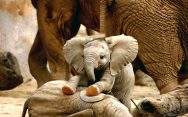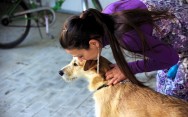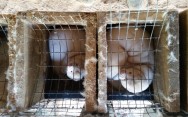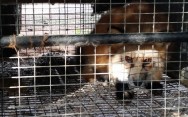Blog Archives
Home -
Archive by category "Trans-Humanist" (Page 4)
“Please forgive me. If I don’t kill you, I can’t feed my family” was the desperate apology a slaughterhouse worker used to whisper to the dogs in their cages in the Cambodian slaughterhouse where he used to work. The worker burst into tears as he described killing up to 6 dogs a day in a Cambodian slaughterhouse. Unlike workers in slick Western meat processing plants who are removed from the killing, Cambodian workers who participate in horrific violence on a daily basis fully experience the reality of what they are doing.
The dogs themselves are rounded up and put into cages and then suffer a drawn-out, tortuous end to their lives. They are transported to the slaughterhouses in crowded cages huddled with other dogs, and kept in rusty cages before being killed. The dogs are killed in brutal, horrific ways with no agreed upon system of killing. Some are hung from trees, others are drowned in fetid water. Some are strangled. Some are stabbed and some are beat over the head. Workers learn to prefer beating dogs over the head because it’s quicker, or drowning them in closed cages so they don’t have to hear their cries.
Yet amid all the horror, somehow there is a ray of light for Cambodian dogs. The organization Four Paws, which has worked tirelessly on behalf of dogs in Cambodia, has succeeded in shutting down the worker’s former employer, one the country’s biggest slaughterhouses. If the closure of this business disrupts the supply chain, it will send a strong message about the acceptability of the dog meat trade in Cambodia. The province of Siem Reap has also decided to ban the trade. But in Cambodia over 3 million dogs a year are slaughtered for the dog meat trade. There is still so much more work to be done to turn the tide against this horrific slaughter.
Four Paws did not just shut down the slaughterhouse, it supported workers to find alternative income and helped some of them to open a grocery store. The organization follows through on an understanding of the relationship between human misery and animal misery. One begets the other as poor workers are forced to kill for a living and dogs die to make profits for rich humans who are conveniently removed from the killing. The kind of clothes that those in business wear are different from the blood-stained rags of hired animal killers, yet it is the clean suits that are the real hallmarks of mass killers.
In a poignant moment, the worker who had murdered the dogs was able to release fifteen of them from their cages when the factory shut down. This time the worker was able to whisper to the animals: “you are free now” In this moment, the workers’ freedom and the animals’ freedom were not different, they were intricately intertwined and impossible without each other.
Please visit Four Paws website and make a donation to support the important work they are doing: four-paws.us/campaigns-topics/campaigns?utm_source=google&utm_medium=grant&utm_campaign=Evergreen&utm_content=UNR1907ADGRNTevergreenBrand&gclid=EAIaIQobChMInt2_1rKq6wIVFIzICh25fAV7EAAYASAAEgLww_D_BwE
https://www.scmp.com/news/asia/southeast-asia/article/3037201/inside-cambodias-brutal-dog-meat-trade-which-claims
History is littered with examples of great atrocity being masked with so-called necessity and the use of neutral or clinical language. Nowhere is that clearer than the way Big Agriculture kills animals in cruel ways with impunity. Animals make it to consideration as numbers on a balance sheet, are killed in their thousands at secret facilities deliberately hidden from the public eye, and die incredibly painful deaths in practices like the unspeakably horrible “ventilation shutdown.”
When farmers can’t get rid of their excess “stock” due to covid-19 affecting meat-packing factories, they shut down the ventilation system, doors and windows of large overcrowded barns filled with pigs until the animals die of “hyperthermia.” Video footage from Direct Action Everywhere showed a barn full of pigs, the camera filling up with steam, and the sound of shrieking as the pigs bodies’ overheated until the steam cleared to show the grey dead bodies of the pigs.
Ag gag laws continue to be passed by different states. Attempts by activists to show the truth are met with charges of terrorism. Even when the images of unbelievable cruelty are accessible to the public, the meat industry continues to fight back. The American Veterinarians Association have come under fire from a rebel group of veterinarians who object to the organization’s approval of the process for mass extermination. Although advocating for this practice may seem extreme and violent, it’s not a surprise. The ability of the agricultural industry to end so many animal lives in cruel ways shows that Big Ag’s brutal regime still controls what is acceptable. Please read more about this issue, share with friends and sign the petition in the following article: https://www.onegreenplanet.org/animalsandnature/iowa-pigs-steamed-to-death/
https://theintercept.com/2020/05/31/animal-rights-map-farms-coronavirus/
https://news.vin.com/default.aspx?pid=210&catId=616&Id=9708475
Mountain lions in California are isolated, dejected, without chance of finding a mate and vulnerable to poisoning, death on highways and deliberate targeting by humans. That is the picture painted by this LA Times Article, ahead of a major decision by the Fish and Game Commission that went in favor of Mountain Lions. The Fish and Game Commission have decided to review the Mountain Lions’ Endangered status over 6 years and afford them certain protections in line with this. The article delves into the ways Mountain Lions should be protected. While these considerations apply to Mountain Lions, it would be even better if some of the protections could be universally applied to protect wild animals in shrinking habitats encircled by human development.
One suggestion the article makes is that highways should not restrict Mountain Lions’ Movements. It seems a no-brainer to require green overpasses for all animals in highway development plans. The needs of wild animals to roam freely and seek food and better conditions are fundamental. Animals may not be imprisoned in Wildlife Parks but encircled by “highways of death” they may as well be.
Then there are poisons. Poisoning animals that are considered pests doesn’t just kill them in an inhumane and horrible way, it also risks the life of any other animal happening upon this poison, whether by predation or by other exposure. Poisoning “pests” is the equivalent of planting landmines in wild animals’ natural habitats. Raptors like owls, for example, are much more likely to die from anticoagulant rodenticides. These poisons induce fatal bleeding in animals. It is an unthinkably cruel way to die.
The only reason people are starting to wake up to this inhumanity is that their own pets are sometimes killed by poisons. The sad and difficult lives of Mountain Lives tell a much bigger story about life for wild animals who are forced into exile on the borders of human habitats.
Read More:
https://www.sanluisobispo.com/news/local/environment/article243374736.html
https://www.sacbee.com/news/california/article237937419.html
https://messengermountainnews.com/mountain-lions-win-major-victory-at-fish-and-game-commission-meeting/
https://www.latimes.com/opinion/story/2020-04-15/mountain-lions-protection-freeways-rat-poison-property-owners
Until Wildlife Services agreed to “cut back” on killings of wild animals in Montana, it might not have been visible to most Montanans that thousands of animals were being killed in Montana every year. In 2018, the most recent year for which data is available, Wildlife Services killed 7,965 coyotes, 46 wolves, one grizzly bear and other species in Montana. Until the settlement with WildEarth Guardians required Wildlife Services to stop exploding sodium cyanide bombs on certain tracts of public and private land, Wildlife Services’s explosion of bombs to destroy animal habitats wasn’t a subject of discussion.
The massacre taking place under our fingertips is still taking place, only at reduced levels. Wildlife Services is an anachronistic name for a violent agency that mostly appears to protect the interests of big farmers and ranchers. Public understanding of these agencies is that they restore balance in livestock predator conflicts and to human/animal interactions. Yet the activity that most undermines balance is protected by Wildlife Services: the livestock industry that endangers the planet through climate change and pollution. The whole system is one in which countless numbers of animals (including cattle) die to feed a machine that requires more killing to perpetuate its existence. By definition any system running on this level of destruction is not sustainable.
WildEarth Guardians have won a battle that requires the Wildlife Services to turn to science to justify their killings; they are now required to review the killings based on updated reports rather than carry them out wantonly. Unfortunately, it has not won the war. Winning the war is only possible when human groups participate in protecting an environment shared with non-human creatures equally.
Read more:
https://montanafreepress.org/2020/05/14/wildlife-services-to-cut-back-killings-pending-environmental-review/
When Whip’s owners’ went to feed their beloved horse in the morning, they found he was gone. Then they wandered into a nearby field where they made a horrific discovery. They found the body of their beloved friend and family member, completely butchered. This was a cold blooded killing: the horse had been butchered in the dead of night, somewhere between midnight and 5am, ostensibly for his meat. There have been other similar incidents in nearby counties, indicating that a killer may well be targeting horses in the local area.
The Sheriff’s Office and the Florida Agricultural Crimes Intelligence Unit are working on this crime and Collier County deputies have increased their presence in areas where people keep horses. Just like serial killers who target humans, it seems vulnerable horses are being preyed upon. Horses can be picked off by killers at their leisure as they graze in fields, powerless to protect themselves.
It is difficult to imagine what Whip went through in his final minutes or hours. The killer worked in the dead of night to butcher Whip, and more than likely took pleasure in the horse’s suffering. Whip’s owners describe themselves as grief-stricken. Their loss is the loss of a family member. They explain how they miss the 8 year old horse Whip, who they adopted as a four year old, and his “great personality.” Their loss is the loss of a sovereign individual who can never be replaced, and worse, a family member who was killed in the most brutal and gruesome way. Whip’s family are offering a $12,600 reward to anyone who can provide info about the person who killed him. This cannot bring back Whip, but if his killer is caught, another horse will not have to endure the unimaginable pain of brutal violence, and another family will not have to grieve the loss of beloved family member.
https://www.nbcnews.com/news/animal-news/family-s-horse-found-butchered-florida-horrific-crime-n1145841
Once again, the fates of humans affects so much more than just us. Coronavirus has put pet shelters into emergency mode. The bad news is that pet shelters are so understaffed that their intake of pets is greatly reduced. The good news is that people are stepping up across the country to adopt and foster pets and take virtual tours to get to know animals. The adoption and fostering of animals is actually up, but then again, pet shelters can’t keep a regular turnover of animals, so stray animals will be adversely affected by this crisis.
Even though adoptions are up, there have been fears about people dumping their pets by the side of the road because of coronavirus fears. As well as being unconscionable, this is completely uninformed. First, there’s the moral failure of abandoning an animal that is dependent on you. If you wouldn’t abandon a relative in your household, you should not abandon a pet. Even if pets were able to spread coronavirus, it’s possible to practice adequate social distancing by keeping them indoors or being careful when you exercise them.
However, there is absolutely no evidence right now that companion animals like dogs and cats can transmit the virus. Though two dogs tested positive for Covid-19, this says nothing about their ability to spread the virus. Testing on animals does reveal a huge tragedy though – the death of pigs and other industrially farmed animals from coronavirus or related illnesses. Pigs have similarities to humans that make them the animals most likely to contract or spread coronavirus. Our insistence on industrially farming animals for meat is the reason for the tragic death of pigs in their huge numbers in this quiet and unreported pandemic.
One way you can protect animals is to stay informed and correct the spread of egregious misinformation that endangers animals. Practicing social distancing with pets and encouraging others to do the same is something else you can do. In many states you can adopt or foster pets and meet them virtually before you pick them up. You can also encourage vegan eating and continue to reject and fight against the hegemony of industrial farming and demand better treatment for all animals.
Read More:
https://www.deseret.com/utah/2020/3/27/21194027/coronavirus-covid-19-animal-shelters-foster-pets
usatoday.com/story/entertainment/celebrities/2020/03/27/animal-adoptions-shelters-get-creative-pair-parents-pets-amid-coronavirus/2907199001/
https://phys.org/news/2020-03-animals-vulnerable-covid-.html
There are times when a death toll goes so high that the significance of numbers is nothing but the complete loss of their significance. No longer are numbers able to speak of the loss of the individual to a community, to a family, to a habitat. The only thing they are able to speak of is the loss of meaning, the incalculable damage done to life itself. When we hear of a human death toll – a disaster, a massacre — the number of dead hits us like a blow to our sense of individual destiny: the right we think we have to thrive, to matter. The dead are like a wave that sweeps across our consciousness, constantly overwhelming our efforts at recognition, at the distinction we humans find between ourselves and others, our environment. We are connected with others in our helpless masses, no longer as helpers or community members, but as mere victims. The numbers stand while we fall, unable to resist the magnitude, the amplitude of the loss.
The numbers of estimated animal dead in Australia cannot be compared to a human village, nor a town, nor even a nation. Instead, the numbers of estimated animal dead in Australia’s fires make up one eighth of the world’s human population today. This animal death toll doesn’t even include frogs and insects.
As humans, we work among the ruins of our own disasters to regain our personal significance. We cling on to activity: gestures of solidarity, statements about change that are as much made to feed the ego as to stake out a real commitment. We reassure ourselves that we are individuals, that we matter. In the wake of Australia’s fires, humans feeding baby koalas and wrapping them in blankets are broadcast as a signal of activity that fills the void of disaster. They speak of our ability to care, to matter, as helpers and agents for animals. Despite the great good of these activities, they do not speak of the loss and grief of animals themselves, nor of their situation as displaced individuals and families who have been devastated by Australia’s inadequate climate change policy.
The animals who have survived have lost their family members and in some cases their entire habitats or livelihoods. The best known example is the Koala, which has been decimated by the fires on Kangaroo island. These koalas had represented a sanctuary and a reserve, protected from the chlamydia that has kept other koalas from reproducing successfully. There are questions over whether a small marsupial which lives its life shielded from danger in greenery has any real shot of sustainable existence in its hollowed out home on Kangaroo island.
We humans imagine death from fire as striking these animals with explosive might, but before the fires, animals were already dying of exposure to intense heat. Birds were dropping out of trees. Animals were starving because their food supplies were drying to a crisp. The fires that have grabbed human attention have left animals homeless. Those who have survived and haven’t received medical attention are enduring great suffering from hunger and injury. The Australia fires have unearthed a world of animals who carry on their lives whether we notice or care or not.
We need to follow the story of animal lives beyond this crisis as they now evade opportunistic predators like feral cats, as livestock dead create bio-hazards for animals, as they move about and use their ingenuity to survive but often fail to make it. Animals, like humans, do what they can to survive, including sheltering together in wallaby burrows. Heroic working dogs have rescued animals from fires. The sight of injured animals, baby koalas clutching stuffed animals, should remind us that other species have their own emotional needs and communities. Everyday animal lives, not human heroism, are the ignored clues to helping animals and working alongside them. For example, it should have been clear by damage from the heat wave in Australia, and by animal behavior, that climate change disaster was already preying upon the animal population. The fear is that California “will be next.” The sovereignty of animal lives needs to be consistently observed and recognized outside of disaster scenarios. Waking up to animal sovereignty, animal pain, animal solidarity can transform the death of animals from a number into an accountability for the loss.
The rescue efforts are not going to stop when the fires start to disappear from the headlines. This article has some information on how to support the rescue efforts going on: https://www.cnet.com/how-to/australia-fires-have-killed-more-than-a-billion-animals-so-far-how-you-can-help/ However, ongoing donations to animal conservation organizations such as the World Wildlife Federation are needed indefinitely. Commitments to fight climate change and move away from animal exploitation and death are needed Right Now.
https://www.latimes.com/environment/story/2020-01-14/australia-fires-killed-millions-of-animals-kangaroo-island
https://www.cnet.com/how-to/australia-fires-have-killed-more-than-a-billion-animals-so-far-how-you-can-help/
https://www.nbcnews.com/science/environment/more-1-billion-animals-killed-australian-wildfires-n1112326
The more access we have to information, the more examples we see of the way animals work together, care for and even comfort each other in sadness and illness. A touching photo of comfort dogs at the vet is the latest example to catch people’s attention. Some vets have dogs whose job is to provide comfort and solace for sick and dying dogs. These dogs are able to care for other dogs by letting them know that everything’s going to be OK, and by just being there in the same way humans are for each other.
It’s remarkable and yet not remarkable. What people are witnessing isn’t just animals being adorable, but animals interacting together just as humans do. Acts of kindness between people can also have this feelgood factor. Caring for other beings is something that doesn’t stop at our own species. The days when there was an easy excuse to see animals as automatic and unfeeling are passing away. All the evidence shows that animals are a parallel society who can organize and bond in deep ways. It’s great that people are sharing these stories, but discovering that animals feel solidarity, comfort and pain should do more than make us feel good. It should awaken us to the bonds we break and the pain we cause when we are violent to animals.
Veterinarian Has A ‘Comfort Dog’ That Assists Sick, Scared Pets
The Taji dolphin hunt is one of the most notorious animal slaughters around the world. Every year animal activists look on in horror and helplessness while entire pods of dolphins are lured into coves in the town of Taji in Japan and slaughtered wholesale. These dolphin families are wiped out in front of each other in the name of local tradition. Other dolphins are rounded up and captured and sold for thousands of dollars to aquariums in China that aren’t compliant with world standards on captive animals. The 2009 movie “The Cove” was made to expose this terrible slaughter and the world’s helplessness to stop it. Ten years later it is still going on.
The film-makers filmed fishermen luring the dolphins into the cove and killing them by stabbing them with knives. Yet the killings somehow still persist. Fishermen and officials claim the killings are now humane. The actual reality of the killings though, are far from this. According to this description, this is how the dolphins die:
“A metal rod is repeatedly stabbed into the back of the dolphin’s neck and a wooden plug is inserted into the open wound to prevent blood loss. This means the dolphins die a slow, painful death, taking several minutes to bleed out or drown in their own blood.” [https://www.theguardian.com/world/2019/feb/13/taiji-dolphin-hunt-activists-to-launch-unprecedented-legal-challenge]
Mere words cannot begin to describe the horror of this slaughter. Close family units of dolphin pods are killed in front of each other in pitifully cruel ways. Some dolphins who don’t die are released and die of their injuries in the wild. Other “perfect specimens” are sold for thousands of dollars to theme parks. It’s difficult to imagine the despair of seeing your whole family killed and then having to live out your life in captivity and isolation. The town of Taji still clings on to its 400 year “tradition” of whaling. The town is so attached to these traditions that the local whale museum has backed away from International agreements among zoos and aquariums not to display captive animals.
Despite the obvious scientific fact that dolphins are mammals, not fish, they are legally classified as fish in Japan, which means they can’t be protected by cruelty laws. The fishermen and town of Taji have a choice to step away from the killing, but as they are legally free to keep hunting dolphins, the killing goes on. Activists are attacking the cruelty by bringing a lawsuit based on the fishermen exceeding quotas and the dolphins’ status as mammals rather than fish.
When we see what humans do to animals we truly enter the realm of the arbitrary. Laws segmenting the animal kingdom into those that can be harmed and those that can’t; brutal “traditions” that humans cling to when it’s no longer a matter of survival; the right to treat animals as chattels and kill and torture them. Killing animals exposes us to the side of our nature that is violent and irrational. In the case of the ritualized Taji killings, we have to look unflinchingly at these practices, but also beyond them. Animal captivity for example, is not a harmless counterpoint to eating animals, it is part of the system that gives animals value as “things” rather than independent beings:
“People need to understand that if they’re planning a vacation down to Mexico and they want to swim with dolphins in captivity, they’re encouraging this behavior and this hunting season to continue.” [https://www.washingtonpost.com/world/2019/10/14/japans-dolphin-hunt-struggle-between-local-traditions-global-anger/]
The killings of Taji should throw a harsh light on the irrationality and cruelty of tradition for its own sake. Any value system in which animals and our fellow humans have a use value to us rather than independent sovereignty of their own, will inevitably become abusive. The killing grounds of the Taji waters are not an outlandish annual event, they are the ritualized nature of violence laid bare.
Read More:
https://www.theguardian.com/world/2019/feb/13/taiji-dolphin-hunt-activists-to-launch-unprecedented-legal-challenge
https://www.washingtonpost.com/world/2019/10/14/japans-dolphin-hunt-struggle-between-local-traditions-global-anger/
This Vice headline sums the Amazon situation up with the kind of bluntness that’s needed at the moment: “Sad About the Amazon Fires? Stop Eating Meat.” The article is a timely correction to the assumption that logging is the reason we are losing the Amazon rainforests. Many posting on social media accounts about the Amazon fires are unthinkingly connecting the damage to “other people”: greedy logging companies etc., when in fact the trail leads directly back to the people posting – many of whom eat meat. Cattle ranching is the leading cause of deforestation in the Amazon, and clearing lands to make way for cattle is what is causing the fires.
The growing demand for meat is driving this destruction, in particular the demand for beef. With plenty of healthy protein substitutes available, the slaughter of cattle is completely unnecessary. Industrial farming harms the environment in other ways through water pollution from slaughterhouses. Animal suffering is an inevitable byproduct of treating animals like products, to be mutilated and packaged. In the tragedy of the Amazon rainforest we can see how this approach to life has outward ripples. When we treat life like an industrial product, when we kill animals brutally, we lack the respect for other life that is ultimately needed to save our own lives and habitats.
Read More:
https://www.vice.com/en_in/article/bjwzk4/feeling-sad-about-the-amazon-fires-stop-eating-meat








Social Media